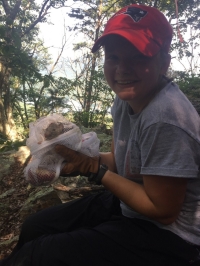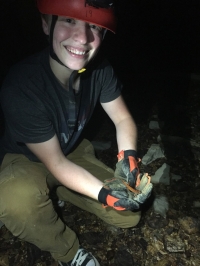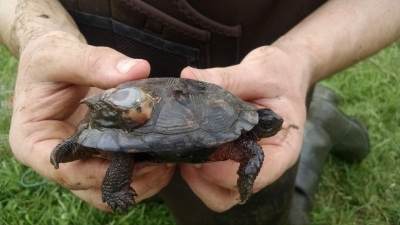- Biology Department
- Pre-Health Advisory Committee
- GIS Center
- Medical Laboratory Science
- Museum of the Earth Sciences
- Mathematics and Statistics
- REALISE
- Chemistry Department
- Radford University Planetarium
- Department of Physics
- Anthropological Sciences
- Geology
- Selu Observatory
- Center for Information Security
- Forensic Science Institute
- Biomedical Science
- Geospatial Science
- School of Computing and Information Sciences
- MS in Data And Information Management
Faculty and students complete wildlife research this summer

This summer was a busy one for faculty and students working with wildlife. Two professors showcase their research and student involvement below:
From Karen Powers:
Students and I worked on several projects, including: (1) surveys of Allegheny woodrats in western Virginia, (2) detection probability of eastern small-footed bats at Devil's Marbleyard, and (3) assessing the health and activity levels of federally-threatened gray bats in far southwestern Virginia. Recent RU Biology graduates Heather Custer and Justin Bentley assisted, along with RU Biology seniors Makayla Beckner (pictured, left, with an Allegheny woodrat) and Sandra Bryan. Senior Ryley Harris also assisted for a day trip.

We worked with colleagues at the Virginia Department of Game and Inland Fisheries, Virigina Department of consevation & Recreation's Natural Heritage Program, and Virginia Military Institute, and Virginia Tech. These were great experiences for students and faculty alike!
Left: Sandra Bryan holds a salamander found in a cave in southwestern Virginia, where we were deploying acoustic detectors to record bat activity.

From Amy Roberts:
I work summers for the Virginia Department of Game and Inland Fisheries as a wildlife biologist assistant, searching for amphibians and reptiles (herpetofauna). This summer, I spent the first half surveying for the federally-threatened, state-endangered bog turtle. Accompanying me were students from Radford University, Virginia Tech, Wytheville Community College, and New River Community College. We set traps for the turtles at sites where they have been studied for decades. For the second half of the summer, students helped me survey for “herps” across far southwestern Virginia. We even documented the presence of some species that had no former county records!
Recent RU Biology graduate, Justin Bentley, holds an old bog turtle with part of a transmitter still attached. A former Virginia Tech grad student studying the species had obviously tracked this turtle using radio telemetry and was really good at attaching the transmitter to the shell! Note the notches on the carapace (top shell), used to identify the same turtle in the future.